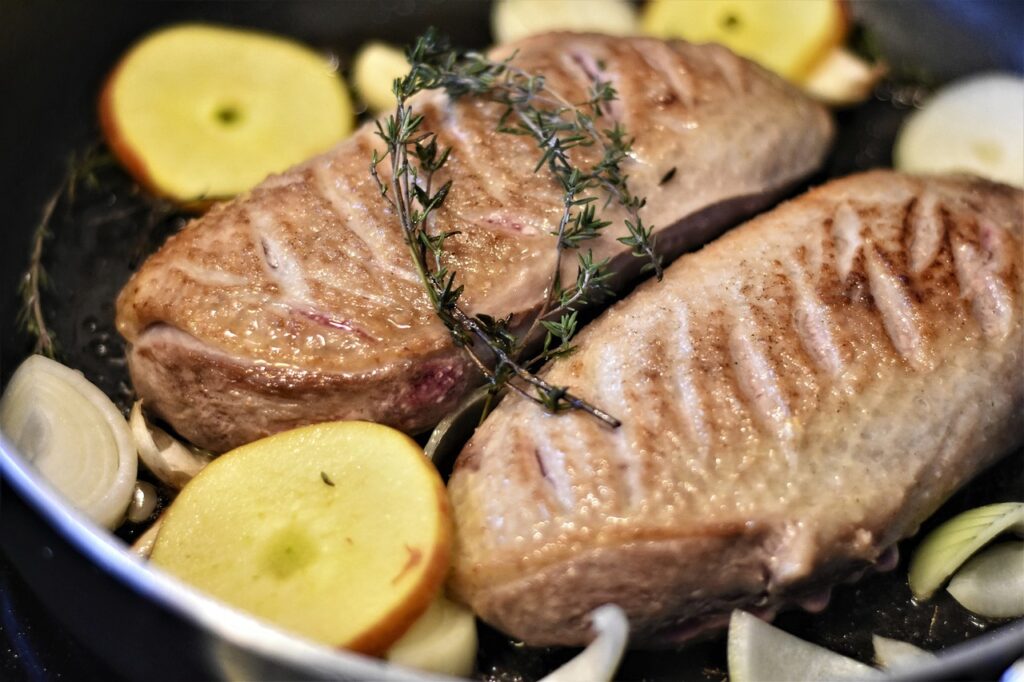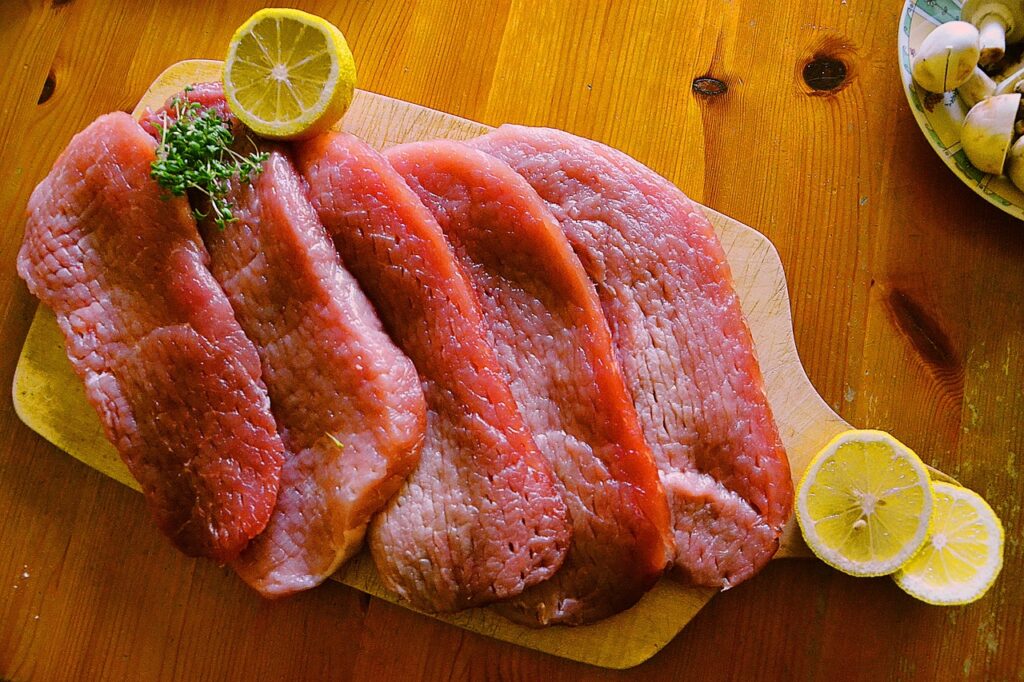Meat is an important diet to man. It has so many benefits that cannot be overstressed. Beyond the fact that all of us like consuming meat, it also enriches our meals with proteins to make them balanced. Meat is merely animal flesh eaten as food, and this supplies the body with a kind of protein called “animal protein.”
The other class of protein, which is ‘plant protein’, is obtained from plants. This (animal) protein our bodies get from meat goes a long way in helping them grow and develop properly. Besides meat, other meat products like eggs, milk, etc., also supply our bodies with the protein they require to grow, develop and function well.
It is amazing how much we love meat! This love is demonstrated in the amount of meat we eat annually. Statistics show that it is around 350 million tons. How does that sound? Lots of love, right? I think so too! But when you consider that meat is one of the most complete dietary sources of protein, it might be easier to appreciate why it’s eaten a lot.
In this piece, having learned how important meat is, we will go on to discover the most consumed meats on our planet and the possible factors that led to their frequent consumption.
8 Most Consumed Meat on the World
1. Pork

Pork is the meat from pigs, specifically those that are commercially raised. Currently, it remains the most popularly consumed meat in the world. This comes from information provided by the United Nations Food and Agriculture Organization (UNFAO), which gives a quick summary of pork being responsible for 36% of all meats produced. More than 100 million metric tons are consumed worldwide every year.
We will explore some reasons why pork has become the most eaten meat globally:
- Pork is more affordable: Unlike other meats like beef and mutton, pork is more affordable. This affordability can be traced to some reasons, including reproduction and maturity rates, processing, and the amount of meat yielded.
- Pigs will bring forth more offspring than beef, for example and their gestation period is shorter too. An average sow (female pig) has a gestation length of about 112 to 119 days (16 to 17 weeks). It is not so for a cow. It takes around 283 days (about 40 weeks) for a calf to be born. Conversely, when a cow gives birth, there is only one baby each time but in the case of sows, there can be up to thirteen piglets per litter.
- Pigs mature faster! While it will take an average calf two years to become mature and fit for slaughter, the piglet gets to maturity between 5 and 7 months. Then, it achieves market weight, which is a weight ranging from 200 to 250 pounds (approximately 91 kg to 114 kg) and is ready for butcher’s block.
- Pigs, however, are relatively cheaper to feed. They are well adapted to transform feed into meat and, thus, have a high meat yield. Beside that, almost all pig carcasses are used most of the time. In fact, many parts of pig bodies can be made into a variety of meats, like ham, bacon and sausage. All these contribute to the cheap prices of pork as they assist the producers and marketers to sell the meat to consumers at cheap prices and at the same time make good profits.
- Pork is nutritious: Pork is usually labelled as red meat due to its higher myoglobin levels. Myoglobin is the protein responsible for meat’s reddish color. However, some cuts of pork, like tenderloin, are leaner to some extent and lighter in color, which is why some people consider them white meat.
- The classification of pork as red meat or white meat can be ambiguous, as the United States Department of Agriculture (USDA) says it is a red meat for two reasons: first of all, its myoglobin is higher than in poultry and fish meat products studied by authors. Second, pigs are classified as livestock, similar to beef and lamb and every animal seen as red meat.
- The National Pork Board, on the other hand, markets the leaner cuts as “the other white meat”. However, more often than not, pork compares very closely to other red meats such as beef and lamb; this is due to higher levels of myoglobin, iron and saturated fat. Yet, it is possible to find less-fat tenderloins that have nutritional values comparable to any white meat, such as chicken or turkey.
- Taking information from ‘Healthline’ into consideration, a 100-gram prepared serving, in this case, ground pork, would equal 297 calories, 25.7 grams of protein, 20.8 grams of fat and 53% of it is water. Carbohydrates, sugar and fibre are on the zero line. This gives a general outlook of the nutritional values to be expected from pork.
- Apart from proteins and fats, pork also has other nutrients like vitamins, minerals and bioactive compounds, which are all beneficial to human health.
- Protein: Pork is proteinous, like any other meat in the market. It is a rich source of proteins for humans and not only that, it contains all nine amino acids necessary for the growth and development of the body. Raw lean pork contains approximately 26% protein and, when dry, may contain as much as 89% protein, which makes it one of the richest sources of protein.
- Fats: The fat content in pork can be significantly different depending on the type of cut that is used. Thus, cuts such as tenderloin are comparatively leaner in fat, while others, such as bacon, contain more fat. The percentage of fat in pork is typically 10-16% and though it can go up to 40%, this depends on the trimming process, feed and diet, breed, and age.
Some of the fat in pork is unsaturated, but it still has some saturated fats that are not so friendly for the heart and should therefore be consumed in small proportions. Both saturated and unsaturated fats in pork are close in quantity, meaning that they are present in nearly equal proportion.
When purchasing pork, it is always advisable to select the parts that have low fat, although the method used to prepare it is significant as well. Reduced oil frying methods like baking, grilling, and boiling are encouraged.
- Vitamins: Pork is rich in B vitamins (thiamine, niacin, B6, and B12) that help release energy from food, build red blood cells, and support nerve function. It also contains vitamin D for strong bones and vitamin E, an antioxidant that promotes healthy cells and immunity.
- Minerals and bioactive compounds: Pork is loaded with minerals like iron, phosphorus, potassium, and zinc, among others. These minerals help with various body functions. It also contains some bioactive compounds like taurine, bioactive peptides, etc., which are important to the body.
2. Chicken

The United Nations Food and Agriculture Organization states that chicken is the second most consumed meat on earth, with about 33% of global meat consumption estimated to be constituted by it. This equals more than 130 million tons annually. In America alone, around fifty billion chickens are killed yearly for their meat.
There are many reasons why chicken is so popular. One thing is that it’s generally cheaper compared to pork and other kinds of meat, which makes it a kind of protein that could be accessed by people in different income brackets.
Secondly, its health benefits are well known. It serves as a lean protein because of its richness in essential amino acids, vitamins and minerals, which give it a lower proportion of saturated fats compared with red meats. Moreover, its versatility in cooking also makes it appealing. Chicken can be prepared in various ways, such as by grilling, roasting or boiling, among others; hence, many people enjoy eating them because they are found in many dishes like fried chicken, chicken soup and chicken curry, among others.
3. Beef

Beef is the third-most-demanding type of meat in the world. The United Nations Food and Agriculture Organization estimates that it consumes roughly one-quarter of the global meat intake (about 24%). Evidently, more than 70 million metric tons of beef are consumed per year and Argentina and Uruguay are among the top consumers.
Beef often costs more than chicken or pork but is valued for its flavor and texture profile, which are different from those of chicken or pork. Beef is also a good source of high quality protein, iron and B-group vitamins. It has a significant place in several favorite dishes, including hamburgers, steaks, stews, and casseroles. They are able to be grilled, roasted and even braised, making this versatile piece of meat a favorite for many home chefs.
Analyzing the beef industry, one should point out that today it develops eco-friendly measures like regenerative grazing and emissions reduction. Thus, beef will continue to be an important protein consumed in the future due to global population growth, increasing incomes in developing countries, and the natural popularity of this product.
4. Lamb
Lamb is one of the most consumed meats, with ancient history behind it and occupying the fourth place in the global demand for meats. According to the United Nations Food and Agriculture Organization’s global meat intake figures, it contributes 5% of the total global meat intake, with over 14 million metric tons consumed annually. Currently, Kazakhstan takes the lion share of this consumption with 27 pounds per person per year, while Greece comes in close second with 25 pounds avidly consumed per person per year.
It would therefore be welcoming to say that the factor that triggers the popularity of lamb is much owed to the way it tastes and the place it holds in many societies. As compared to chicken, pork and beef, lamb meat is slightly more costly; however, it is consumed for celebrations and certain ethnic recipes in several parts of the world. It is also a dense source of proteins; hence, it comes with all the essential vitamins and mineral nutrients needed by the body. It is tender and preferred in various prepared meals such as lamb chops, roasted lamb, and curies.
5. Goat meat
Goat meat is the fifth most popular type of meat in the meat market. It takes the 5% division with lamb, as the statistics provided by the United Nations Food and Agriculture Organization show that people consume more than 6 million metric tons of it annually.
This makes goat meat popular since it has a special taste, cultural importance, and nutritional value. Despite being more expensive than other commonly consumed meats, goat meat is accepted for being free of fat and having a unique taste. More so, compared to most of the meat varieties commonly consumed, goat meat is leaner and free from cholesterol, calories and fats, meaning that it is healthier for people who are more conscious of the kinds of foods they are taking.
6. Turkey
Turkey is one of the lean meats frequently consumed worldwide and ranks as the sixth most consumed meat in the world. Currently, gobbling turkey has become a global phenomenon and every year, 5 million and above metric tons of turkey meat are consumed. According to recent statistics concerning per capita consumption, the USA takes the lion share of the entire global consumption by consuming 16 pounds per individual annually.
Indeed, turkey, like the other meats, has various qualities that explain why consumers love it. Thus, turkey is leaner in terms of caloric content and fat than beef or pork and is therefore appealing to the consumer who is health-conscious.
This meat is versatile enough in the kitchen to be the main character of a variety of dishes, from conventional celebrations of the end-of-year holidays to the commonplace, a simple sandwich, a salad, and a soup. Turkey is famous for its food internationally; it has cuisines that are associated with the Western world and the Middle Eastern region.
7. Duck meat

Currently, duck meat is on the list of the top seven consumed meats in the world. Although it occupies a very small portion of the global meat market when it comes to other protein products. It occupies a rather important place in the cultures of certain countries in East Asia, for instance, China and Vietnam. On the same note, China is home to almost 65% of the world’s duck meat production.
People consume it for facets such as its taste. When fried, the fat on the skin results in a crust that locks in the juicy flavors of the meat inside. Duck dishes can range anywhere from the elegant Peking duck to the rustic confit. Duck meat also contains nutrients such as protein, Iron and selenium.
8. Buffalo meat
The last item on this list, buffalo meat, which is also named bison, ranks as the eighth most popular meat in global consumption. It has been recognized in the recent past due to extensive acknowledgement of its low-calorie and nutrient-parsed meal. Currently, buffalo is ranked eighth among the species most commonly consumed, and it may constitute about 1.5% of total meat intake, with India leading in both the production and consumption of the meat.
Loaded with protein, iron and B-group vitamins, buffalo meat is fast gaining popularity among health-conscious people. Its taste is robust, slightly sweet, and not like any other red meat such as beef, and it is lean, making it a better option.
Conclusion
Thus far, we’ve seen how studying the most common meats across the world allows us to discover more about the world’s eating habits and cuisines. From pork and chicken to buffalo and even ducks, all these protein sources have very special and distinct taste profiles with different nutrients.
As we view these various meat types as we traverse the daily dynamic food choices that are present, it becomes important to learn and embrace more of these types while being considerate to the environment and the various ethnicities globally.




